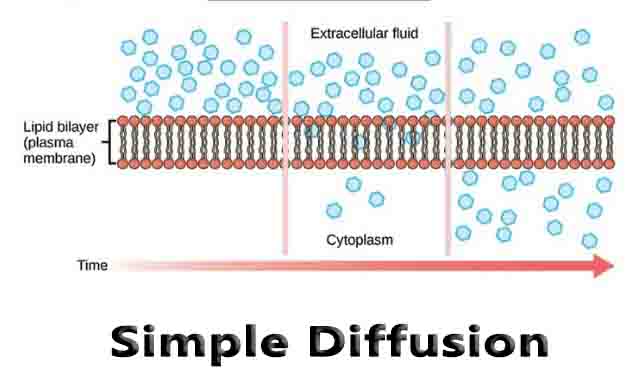Simple Diffusion Definition
Simple diffusion is the process by which solutes are moved along a concentration gradient in a solution or across a semipermeable membrane. Simple diffusion is carried out by the actions of hydrogen bonds forming between water molecules and solutes. Water molecules move in to surround individual solute molecules, which maximizes hydrogen bonding.
Hydrogen bonds are extremely temporary, however, and the solution is constantly stirred as a result. This helps distribute the solute evenly throughout the solution. If the molecules are small enough, this simple diffusion can happen across cell membranes, between the individual phospholipids that make up the membrane.
Water can move along its concentration gradient through a cell membrane in this manner, a form of simple diffusion known as osmosis.
Unlike simple diffusion, cell membranes often incorporate specialized membrane proteins which help transport substances across the membrane. This is known as facilitated diffusion. Facilitated diffusion includes both the active and passive transport of solutes across the membrane.
Active transport uses ATP to provide energy to the proteins providing the transport. Unlike in simple diffusion, molecules can be moved against their gradient using active transport systems. Simple diffusion is present in a number of biological systems, including the delivery of oxygen, water, and other small molecules to the cells of the body.
While many solutes have the ability to traverse the membrane via simple diffusion, cells will often have protein channels to help speed the process.
Examples of Simple Diffusion
Carbon Dioxide
Carbon dioxide is a small molecule that can be dissolved into water. If you’ve ever enjoyed a bubbly soda, you know this. However, you might not know that the same mechanism is transporting the carbon dioxide that your cells create into your bloodstream and out of your body via your lungs.
Carbon dioxide is small enough to move through simple diffusion through your tissues and out of your body. If you hold your breath for a short time, you will begin to feel a burning “desire to breathe”. This is caused by the accumulation of carbon dioxide in sensitive nerve tissues in your bloodstream, lungs and brain.
When you begin to breathe again, the carbon dioxide diffuses out of your system. Many gases are able to do this through your lungs including oxygen, nitrogen, and many others in the atmosphere.
Bacteria
Being the simple organisms they are, bacteria have no way to intake nutrients other than diffusing them across the cell membrane. While they do use facilitated diffusion to transport most nutrients, they rely on simple diffusion to deliver oxygen, water and small nutrients to the cytoplasm.
Within their cells, there are no specialized organelles to hold or transport substances, so bacteria rely on the simple diffusion of material within their cells to ensure materials are present for the reaction that control their life processes.
Related Biology Terms
- Facilitated Diffusion – The distribution of a substance across a cell membrane using specialized embedded transport proteins.
- Passive Transport – The use of proteins to facilitate the diffusion of a solute along its gradient across a cell membrane.
- Active Transport – The use of proteins and energy to transport substance, even against their gradient across a membrane.
- Osmosis – The simple diffusion of water along its gradient in a solution or across a membrane.

